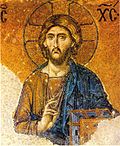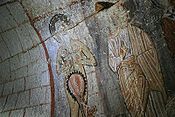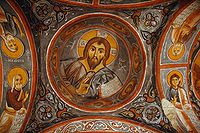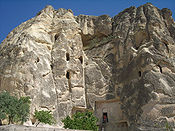- Churches of Göreme, Turkey
-
Part of a series on Eastern Christianity 
History Orthodox Church History
Specific regions:
Byzantine Empire
Ecumenical council
Christianization of Bulgaria
Christianization of Kievan Rus'
East-West Schism
Asian Christianity
Coptic Egypt · UkraineTraditions Orthodox Church
Others:
Oriental Orthodoxy
Ethiopian Tewahedo Church
Coptic Church
Church of the East
Eastern Catholic Churches
Syriac ChristianityLiturgy and worship Sign of the cross
Divine Liturgy
Iconography
Asceticism
OmophorionTheology Hesychasm · Icon
Apophaticism
Filioque clause
Miaphysitism
Monophysitism
Diophysitism
Nestorianism
Theosis · Theoria
Phronema · Philokalia
Praxis · Theotokos
Hypostasis · Ousia
Essence vs. Energies
MetousiosisGöreme is a district of the Nevşehir Province in Turkey. After the eruption of Mount Erciyes about 2,000 years ago, ash and lava formed soft rocks in the Cappadocia Region, covering a region of about 20,000 km2. The softer rock was eroded by wind and water, leaving the hard cap rock on top of pillars, forming the present-day fairy chimneys. People of Göreme, at the heart of the Cappadocia Region, realized that these soft rocks could be easily carved out to form houses, churches, monasteries. These Christian sanctuaries contain many examples of Byzantine art from the post-iconoclastic period. These frescoes are a unique artistic achievement from this period.
In the 4th century small anchorite communities began to form in the region, acting on instruction of Saint Basil of Caesarea. They carved cells in the soft rock. During the iconoclastic period (725-842) the decoration of the many sanctuaries in the region was held to a minimum, usually symbols such as the depiction of the cross. After this period, new churches were dug into the rocks and they were richly decorated with colourful frescoes.
Contents
Tokalı Kilise
Tokalı Kilise (or the Church of the Buckle), is the largest church in Göreme. Restoration of the church was completed during the 1980s.
One noted feature of the church is the main nave containing ninth century frescoes in "provincial" style, the more recent additions are three apses of the 11th century frescoes, which are rendered in "metropolitan" style. The church contains frescoes of the twelve apostles, the saints and scenes from the life of Jesus (963-969 and 11th century respectively). The church also has a crypt underneath the nave. The Buckle Church is formed of four chambers: the Old Church, the larger New Church, the Paracclesion, and the Lower Church. The Old Church dates to the 10th century. It was originally a single-naved barrel-vaulted church. But its apse was destroyed when the New Church was added at the end of the 10th or early 11th century. Now the Old Church provides entrance to the New Church. The Old Church is decorated with pale hues of red and green painted in strips to represent scenes from the New Testament and depictions of some saints. Panels of rich indigo painted with pigments from the lapis lazuli stone dominate the New Church : scenes from the New Testament, miracles of Christ, the first deacons, episodes from the life of St. Basil (one of the Cappadocian Fathers), depictions of Leades (one of the Forty Martyrs) and St. Menas. The New Church was carved out of the eastern wall of the Old Church and decorated with Eastern-style arches and a series of arcades. The Paracclesion, located at the left side of the New Church, is a barrel-vaulted chapel with a single apse. The Lower Church has three aisles and a burial space or krypto.
Elmalı Kilise
Elmalı Kilise (or the Apple Church) a smaller cave church. Was built around 1050 and has carved into four irregular pillars the sign of a Greek cross with these pillars support its central dome. Restoration on the church was completed in 1991, but the frescoes continue to chip off, revealing a layer of earlier paintings underneath. The church's paintings depict scenes of the saints, bishops, and martyrs. and to the right of the altar, a Last Supper with the symbolic fish (the letters of the word fish in Greek, ΙΧΘΥΣ, stand for "Jesus Christ, Son of God, the Savior"). The name of the church is believed to refer to a reddish orb in the left hand of the Archangel Michael in the dome of the main apse, or possibly to an apple tree that grew in the vicinity.
Azize Barbara Kilisesi
 Fresco of Christ Pantocrator in Azize Barbara Kilisesi
Fresco of Christ Pantocrator in Azize Barbara Kilisesi
Azize Barbara Kilisesi, (or the Church of Saint Barbara) Barbara was an Egyptian martyr who was imprisoned by her father in order to protect her from the influences of Christianity. Barbara nevertheless found a way to practice her faith and her father tortured and killed her.
Built in the late 11th Century, the church was possibly built as a tribute to the Martyr-Saint. The church has the same layout as Çarikli Kilise. The church has a cross-dome with one central apse, two side apses and two columns. The dome depicts Christ on the Throne, with geometrical patterns painted in red ochre, painted directly on the rock, believed to be symbolic in nature. Another fresco with the large locust possibly representing evil, which is warded off by the protection of two adjacent crosses. The north wall of the church contains a fresco of St. George and St Theodore on horse-back struggling against the dragon and snake. The monks drew red ochre lines on the rocks, to give the impression that cut stones were used in the construction.
Yilanlı Kilise
 Fresco of Onuphrius (on left)
Fresco of Onuphrius (on left)
Yilanlı Kilise(or the Snake Church) is a simple barrel-vaulted church with a low ceiling and long nave. It is named for the frescoe of Saints Theodore and St George slaying the dragon (or snake as depicted in the frescoe). The church also has a frescoe of Emperor Constantine and his mother Saint Helena depicted holding the "True Cross." Legend has it that she discovered the cross upon which Jesus was crucified after seeing it in a dream, and that a piece of the cross is still buried in the foundations of the Hagia Sophia in Istanbul. Other sections of the cross are in the Church of the Holy Sepulchre and in St. Peter's in Rome. Another interesting portrait is the one of Saint Onuphrius on the upper wall to the right of the entrance. The saint lived the life of a hermit in the Egyptian desert near Thebes, Egypt and is usually depicted with a long gray beard and wearing only a fig leaf.
Karanlık Kilise
 Fresco of Christ Pantocrator on the ceiling of Karanlık Kilise
Fresco of Christ Pantocrator on the ceiling of Karanlık Kilise
Karanlık Kilise (or the Dark Church) was a monastic compound built in the 11th century. It is a domed church with one main apse, two small apses and four columns. It was decorated with scenes from the New Testament: Christ Pantocrator, Nativity, Adoration of the Magi, First Bath, Last Supper, Betrayal of Judas, Crucifixion, Anastasis.
After the Turkish invasion it was used as a pigeon house until 1950s. After 14 years of scraping pigeon droppings off the walls, these newly restored frescoes, depicting scenes from the New Testament, are the best preserved in all of Cappadocia and a fine example of 11th-century Byzantine art. Part of the narthex or vestibule however collapsed opening part of the church's roof to the sky. This caused damage to the fresco with Christ’s Ascension and the Benediction of the Saints, whereas the other scenes only partially remain where the wall collapsed. The church's name possibly comes from a small oculus looking out of the narthex which only lets in a very small amount of light. This feature is what has preserved the richness of the pigments and allowed them to survive the passage of time.
Çarıklı Kilise
Çarıklı Kilise (the Church with Sandals) the name comes from the two footprints at the bottom of the Ascension fresco at the church's entrance (this fresco is said to be an exact copy of the one contained at the Church of the Ascension in Jerusalem). The church is cut into the same rock as Karanlik Kilise. The footprints themselves, have many unconfirmable legends attached to them. The church is carved into a cross floor plan with intersecting vaults. The church's frescoes, which date to the 11th century, contain the four Evangelists, the Nativity and the Crucifixion, the Baptism, the Adoration of the Magi, and other New Testament themes.
See also
- Demre
- Derinkuyu Underground City
- Ephesus
- Kaymaklı Underground City
- Kuştul Monastery
- Last House of the Virgin Mary
- Mokissos
- Monastery of Mardin
- Spiro Kostof
- Sümela Monastery
- Underground cities in Avanos
References
Further reading
- Caves of God: Cappadocia and its Churches by Spiro Kostof Publisher: Oxford University Press, USA (August 3, 1989) ISBN 0195060008 ISBN 978-0195060003
External links
 UNESCO World Heritage Sites in Turkey
UNESCO World Heritage Sites in TurkeyAegean Hierapolis / Pamukkale · Xanthos / Letoon1
Black Sea Hittite Capital of Hattusa · Safranbolu
Central Anatolia Göreme and Rock Sites of Cappadocia · Great Mosque and Hospital of Divriği
Marmara Archaeological Site of Troy · Historic Areas of Istanbul · Selimiye Mosque and its Social Complex
Mediterranean Xanthos / Letoon1
Southeastern Anatolia Mount Nemrut in Commagene
1 Shared with other region/sCategories:- World Heritage Sites in Turkey
- Towns in Turkey
- Cappadocia
- Churches in Turkey
- 4th-century church buildings
Wikimedia Foundation. 2010.



